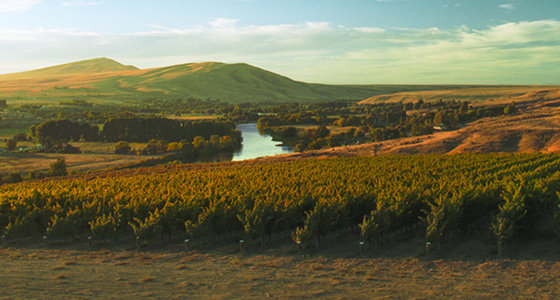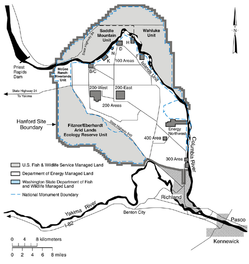Previously on Cornichon: the Gulf oil disaster and the threat to Bristol Bay salmon.

Photo: Artz Vineyard on Red Mountain, courtesy Washington Wine Commission
So here's one that hasn't happened yet. Can't happen, won't happen. Trouble is, if it were to happen, there's no blow-out preventer to stop it.
Hanford, "home" to this country's largest stockpile of plutonium waste, adjoins the Columbia River in eastern Washington. The Columbia Valley AVA (American Viticultural Area), covering virtually the entire Columbia basin, is also the country's largest, by acreage.
According to a recent article in the New York Times, the amount of plutonium buried at the Hanford Nuclear Reservation in Washington State is nearly three times what the federal government previously reported, a new analysis indicates, suggesting that a cleanup to protect future generations will be far more challenging than planners had assumed.
"The Department of Energy sits on the nation's biggest nuclear nightmare. Its inventories of highly radioactive and toxic wastes defy comprehension," says Tom Carpenter, executive director of the Hanford Challenge "The escape of even a small fraction of such material into the environment would constitute a Chernobyl-sized catastrophe."
The Washington Wine Commission says it has "no information" about the plutonium stockpile sitting atop its vineyards and referred questions to the Department of Agriculture. Individual wineries remain mum. An Ag spokesman says the department is "ready," with a three-year-old pamphlet and a recently updated emergency-preparedness web page that talks about a ten-mile evacuation zone in the event of a "plume" but nothing about a possible underground leak or release of radioactive contaminants into the soil or groundwater.
 And yet, agriculture is at the heart of eastern Washington's economy. Some 40,000 farms throughout Washington employ 200,000 workers and generate $40 billion in revenue. The state's four leading agricultural counties (Yakima, Grant, Benton and Franklin), responsible for $3.5 billion worth of crops, actually adjoin the Hanford Nuclear Reservation, with Walla Walla, in fifth position, only 20 miles downstream.
And yet, agriculture is at the heart of eastern Washington's economy. Some 40,000 farms throughout Washington employ 200,000 workers and generate $40 billion in revenue. The state's four leading agricultural counties (Yakima, Grant, Benton and Franklin), responsible for $3.5 billion worth of crops, actually adjoin the Hanford Nuclear Reservation, with Walla Walla, in fifth position, only 20 miles downstream.
One reason the plutonium is stored at Hanford in the first place is the dry climate; it's assumed there will be no torrential rains leaching through the contaminated soils. The slightest leak, however remote the possibility, would compromise the state's image and stature as an agricultural breadbasket. Washington leads the nation as a producer of apples, sweet cherries, and hops; it ranks second in potatoes and wine grapes. But while apples and cherries are sold as fresh fruit, and potatoes are ground up and smooshed into french fries, the grapes are more valuable in their processed form: premium wine, a product that carries the Washington State brand far beyond the state's borders. A bottle of Quilceda Creek cabernet sauvignon from the Yakima Valley does more for Washington's image in the Other Washington than, say, Doc Hastings.
Or Dino Rossi. Or Patty Murray. Hanford is largest nuclear waste storage site in the US; others are in South Carolina, Idaho and Nevada, but the Obama administration has decided to close Nevada's Yucca Mountain facility. That's a win for Senate Majority Leader Harry Reid of Nevada, whose NIMBY protests carry more weight than Sen. Murray's at the White House. Rossi and Murray are in agreement on one issue: ship as much nuclear waste as possible, as soon as possible, out of Washington's back yard..
So here we are at the end of the tale. Take a deep breath, pour a cup of coffee and throw a muffin in the toaster. Time to think about the heart of breakfast. Time to behold nature's perfect food: the egg.
Leave a comment